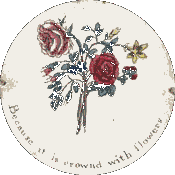Thaumatrope
From Wikipedia, the free encyclopedia
A thaumatrope is a toy that was popular in Victorian times. A disk or card with a picture on each side is attached to two pieces of string. When the strings are twirled quickly between the fingers the two pictures appear to combine into a single image due to persistence of vision.
The invention of the thaumatrope is usually credited to Peter Mark Roget, who used one to demonstrate persistence of vision to the Royal College of Physicians in London in 1824. He based his invention on ideas of the astronomer John Herschel and the geologist William Henry Fitton, and some sources attribute the actual invention to Fitton rather than Paris. Others claim that Charles Babbage was the inventor.
Examples of common thaumatrope pictures include a bare tree on one side of the disk, and its leaves on the other, or a bird on one side and a cage on the other. They often also included riddles or short poems, with one line on each side.
Thaumatropes were one of a number of simple, mechanical optical toys that used persistence of vision. They are recognised as important antecedents of cinematography and in particular of animation.
The coined name translates roughly as "wonder turner" in modern Greek.
[edit] Thaumatropes in Popular Culture
In the Tim Burton film Sleepy Hollow, the thaumatrope is on a necklace which Johnny Depp's character Ichabod Crane carries with him.
In the film The Prestige, Michael Caine's character repeatedly uses a thaumatrope as a way of explaining persistence of vision.
Louis XIV's music video for "Guilt by Association" was inspired by thaumatrope. The video is edited in a way that even if only one member is on the screen, the other can be seen by persistence of vision.
[edit] See also
- Electrotachyscope
- Episcotister
- Flip book
- Phenakistoscope
- Praxinoscope
- Strobe light
- Tachometer
- Zoetrope
- Zoopraxiscope
| Wikimedia Commons has media related to: Thaumatrope |


